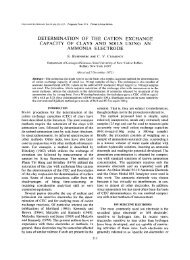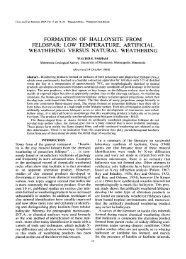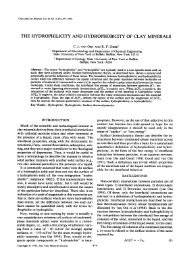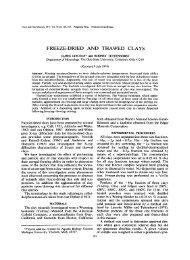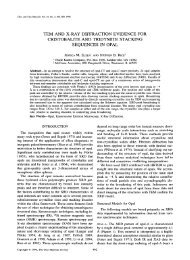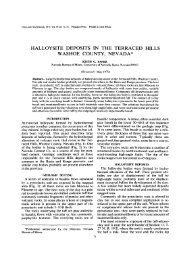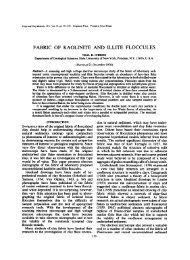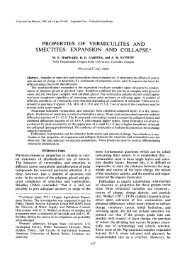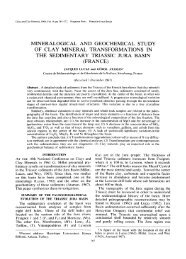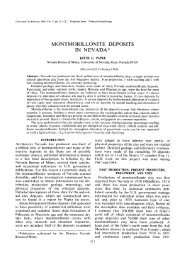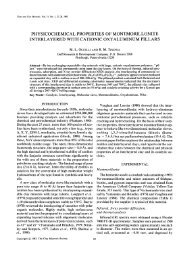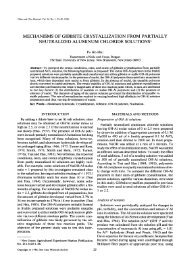Cation-exchange capacity (cec) of zeolitic - Clay Minerals Society
Cation-exchange capacity (cec) of zeolitic - Clay Minerals Society
Cation-exchange capacity (cec) of zeolitic - Clay Minerals Society
Create successful ePaper yourself
Turn your PDF publications into a flip-book with our unique Google optimized e-Paper software.
Vol. 47, No. 6, 1999 CEC <strong>of</strong> zeolites: ammonium acetate saturation 695<br />
2*O ~OmNl. ~LYEGO$<br />
~ 15o S<br />
* o<br />
90 y = 0 9292x + 29 044 --7~''<br />
E i ,~." ..... F~dudJng po]yegos ~ple~ p2L P23,1127 ~d p30<br />
,."~. - _ _ ~adudlag all S~tonm and Polycgos ~p]~<br />
~ [ 30 ~ .... 2"" ~ r = 10432x+ ii 908<br />
CEC (m~l~ g): ~a El~e T~iq~ (1~ NaCI)<br />
Figure 5. CEC values (meq/100 g) obtained using the am-<br />
monia electrode technique with the NH4 + solutions obtained<br />
by washing the NH4+-saturated samples <strong>of</strong> zeolites with 10%<br />
NaCI vs. CEC values (meq/100 g) obtained using the am-<br />
monia electrode technique directly with the NH4+-saturated<br />
samples <strong>of</strong> zeolites (no prior washing with 10% NaC1). The<br />
correlation coefficient is 0.948 (including all samples from<br />
Santorini and Polyegos) for the regression analysis. If the<br />
three kaolinite samples P23, P27, and P30 from Polyegos,<br />
which exhibit minimal differences in their CEC values, are<br />
omitted, then, the correlation coefficient value is 0.884. If P21<br />
is omitted also the correlation coefficient value is 0.823.<br />
dard 1 M NH4C1 solutions. Although ion selective<br />
electrodes may suffer in accuracy when ions <strong>of</strong> similar<br />
valency are present (Busenberg and Clemency, 1973),<br />
the ammonia electrode is not an ion selective elec-<br />
trode. The ammonia electrode is a gas-detecting elec-<br />
trode sensitive to dissolved ammonia (not ammonium).<br />
The electrode has a hydrophobic membrane permeable<br />
to ammonia, but not to any ionic species. Busenberg<br />
and Clemency (1973) used the electrode successfully<br />
with NH4+-saturated clays, and they found that the am-<br />
monia electrode has virtually no interferences, in con-<br />
trast to most other electrodes.<br />
Thus, the differences in CEC are not related to ex-<br />
perimental or laboratory conditions, or ion interference.<br />
Apparently, the NH3 obtained from the NHn+-saturated<br />
samples was higher than the NH3 produced by the NH4 +<br />
solutions obtained by washing the NH4+-saturated sam-<br />
pies with 10% NaC1. Presumably, the release <strong>of</strong> the<br />
saturating NH4 + ions, after the NHn+-saturated samples<br />
were washed with 10% NaC1, was not complete for the<br />
majority <strong>of</strong> samples used here and some NH4 + ions re-<br />
main trapped in the zeolite minerals.<br />
The CEC <strong>of</strong> zeolites should reflect the amount <strong>of</strong> a<br />
saturating ion (principally NH4 +) adsorbed at a specific<br />
pH when the zeolite samples come in contact with a<br />
relevant solution. Problems may occur in the measure-<br />
ment <strong>of</strong> the CEC <strong>of</strong> zeolites using methods that may<br />
be applicable to other minerals. For example, the in-<br />
sufficient <strong>exchange</strong> <strong>of</strong> NH4 + ions as described above<br />
is a serious drawback in applying AMAS to zeolites<br />
if the procedures <strong>of</strong> Bain and Smith (1987) for clays<br />
are followed. Other factors influencing the CEC may<br />
include improper grinding procedures (i.e., reducing<br />
size), the application <strong>of</strong> heat, the change <strong>of</strong> composi-<br />
tion <strong>of</strong> the zeolite to a single cationic form (e.g., Na<br />
<strong>exchange</strong>), or the change in nature and concentration<br />
<strong>of</strong> the saturating ion. The simultaneous application <strong>of</strong><br />
more than one <strong>of</strong> these treatments in all their possible<br />
combinations may further change the apparent CEC.<br />
By applying the various physical and chemical treat-<br />
ments we may obtain the highest possible CEC value<br />
for a zeolite sample. However, comparable CEC val-<br />
ues for zeolites may be difficult to obtain. Instead, a<br />
technique that provides a common approach and com-<br />
parable CEC values for zeolites is most valuable.<br />
SUGGESTED TECHNIQUE FOR MEASURING<br />
THE CEC OF ZEOLITES<br />
The technique proposed here consists <strong>of</strong> three major<br />
parts: (1) sample preparation, (2) saturation <strong>of</strong> the sample<br />
with NH4OAc and <strong>exchange</strong>, and (3) conversion <strong>of</strong> NH4 +<br />
ions to NH 3 and measurement <strong>of</strong> the NH 3 produced.<br />
Sample preparation<br />
Fine powders (



